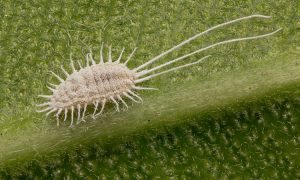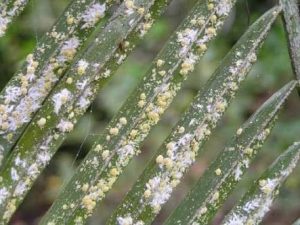 Often, we find the fruits and vegetable spoiled with white scales and spots. Where do these scales and spots come from?
Often, we find the fruits and vegetable spoiled with white scales and spots. Where do these scales and spots come from?
Those are from the mealy bugs!
Mealybugs belong to the group of scale insects. They can be found all over the world, except in the Polar Regions. Mealybugs prefer warm, humid areas that provide enough food i.e. plants.
Mealybugs can reach 0.04 to 0.1 inches in length. The color of the body depends on the species. They can be white, gray, yellow, pink or purple colored. Mealybugs have oval, segmented body without a hard shell on the surface. Some species have a tail-like structure at the end of the body or filaments which create the impression of numerous legs. Females are covered with white, cottony wax that is responsible for the mealy appearance, hence the name “mealybugs”. This layer prevents loss of water from their soft body. Males look like gnats. They have wings, but they lack mouth (they do not eat). Females and immature mealybugs are herbivores. They can be found on the bark, stem, leaves, flowers, and fruit.
Mealybugs use specially designed straw-like mouth apparatus called “styles” for the extraction of sap from the plant tissue. Mealybugs release sugary liquid called honeydew which is the waste product of their diet. This liquid represents a suitable medium for the fungi which quickly spread on the surface of the host plant and prevent photosynthesis by blocking sunlight. Mealybugs reduce the number of nutrients in the plant tissue and inject toxic saliva which prevents normal growth and development of plants. Some species of ants protect mealybugs against predators and use plant material and soil to construct shelters for them. In return, mealybugs secrete honeydew which represents an excellent source of food for ants. Green lacewings and ladybugs are natural enemies of mealybugs. Mealybugs can produce offspring all year round, with a peak during the spring and autumn, temperature and humidity are optimal during these periods of the year.
 Females lay eggs or give birth to live babies, depending on the species of mealybug. Egg-laying females produce 200 to 600 eggs and wrap them in a waxy cocoon. Newly hatched mealybugs, better known as “crawlers”, emerge after 6 to 14 days. Mealybugs have incomplete metamorphosis (holometabolous insects). They undergo 4 (females) to 5 (males) larval stages before they reach adulthood. Parasitic wasps that lay eggs and hatch inside the young mealybugs are used as a biological weapon against these insects. Females can survive a few months, while males die as soon as they fertilize females.
Females lay eggs or give birth to live babies, depending on the species of mealybug. Egg-laying females produce 200 to 600 eggs and wrap them in a waxy cocoon. Newly hatched mealybugs, better known as “crawlers”, emerge after 6 to 14 days. Mealybugs have incomplete metamorphosis (holometabolous insects). They undergo 4 (females) to 5 (males) larval stages before they reach adulthood. Parasitic wasps that lay eggs and hatch inside the young mealybugs are used as a biological weapon against these insects. Females can survive a few months, while males die as soon as they fertilize females.
They quickly reproduce and produce significant damage on the plants in the gardens and greenhouses and in the fields on commercially important crops such as pineapples, grapes, sugarcane, coffee, citrus, and orchids.
Prematurely dropping fruit and stunted plant growth may indicate the presence of the mealybug. This is a result of the mealybugs, in both the nymph and adult stages, sucking the juices of the plant and feeding on any tender young growth.
Mealybugs can be found on potatoes, fruit crops, ornamental plants, citrus plants and tropical plants. They are more common in warm, moist climates but they seem to be able to flourish in greenhouses in all regions.
Yellowing, withering and falling leaves, prematurely dropping fruit, and stunted plant growth may indicate the presence of the mealybug. This is a result of the mealybugs, in both the nymph and adult stages, sucking the juices of the plant and feeding on any tender young growth.
Leaves may wither and fall. Fruit that drops prematurely is inedible and unmarketable. Stunted plants will not be able to fully produce fruit or leaves. The honeydew left by the mealybugs may bring sooty mold fungus to the plant. Plants can die if the infestation is large.
Since the mealybug secretes a waxy substance that it uses to protect itself, its eggs, and the young nymphs, it is often difficult to find an effective chemical control that will penetrate the substance.
Below is the evidence of mealybug menace.
Mealybugs place banana imports in jeopardy
Owain Johnston-Barnes
Published Feb 1, 2020

Mealybug egg mass in a banana bunch found in an inspection last year
(Photograph provided)
Pest problems could lead to a shortage of bananas in the next few weeks.
A spokeswoman for the Department of Environment and Natural Resources said yesterday that officials had worked with importers to tackle pest contaminations — and the
expensive inspection process needed to block the pests.
The problem started when a large number of bananas imported from South America and Central America in late 2018 were found to be infected with scale and mealybugs.
Walter Roban, the Minister
of Home Affairs, said: “The number of live mealybug and mealybug eggs found was alarmingly high and posed a serious risk to Bermuda’s banana industry, local crops and ornamental plants.
“The scale insect infestation was equally concerning as live scale and eggs were detected on all parts of the imported banana fruit.”
Mr Roban added that the species of mealybug found on the bananas was not known in Bermuda.
New Zealand mealybugs invading Britain and destroying gardens
By Henry Bodkin – 25 February 2017 – Telegraph
Many gardeners are plagued by mealybugs in their greenhouses, feasting on the roots of their prized plants.
But now the insects’ even hardier New Zealand relatives have invaded Britain, and they are leaving a trail of destruction in their wake.
Golden root mealybugs have already devastated two gardens in Scotland, with the owners understood to be so upset that they do not want their plight publicized.
Mealybug can destroy your citrus crop
By Gys Helm 2nd November 2017
All citrus farmers are acquainted with the mealybug. In recent years there has been a major increase in mealybug infestation in citrus due to several factors, including warmer winters.
In South Africa, producers plant quite a lot of citrus every year and this contributes to a monoculture system that creates a more favorable habitat for the pest. We have also been experiencing warmer winters in the northern regions, which led to more mealybugs surviving the winter months. The chemicals then used to combat other pests such as thrips, are detrimental to mealybug predators and parasites.
They also facilitate the spreading of various plant diseases. People use various chemical (pesticides and insecticide soaps) and biological (animals that feed on mealybugs) methods to eradicate them. Despite huge efforts, mealybugs are still numerous around the world.
The bugs can cause immense nuisance and hence a method to stop the nuisance is a must.
C Tech Corporation has a solution against leaf mealy bugs menace.
We, at C Tech Corporation, have thought about this problem in detail and have come up with a viable solution. The solution is named as Combirepel™. We are the sole manufacturers of the product Combirepel™.
Our company believes in the principles of sustainability and eco-balance. We do not want to imbalance the cycle of life; therefore Combirepel™ can be easily described as insect aversive, used also against all types of insects and which works on the mechanism of repellency. It means that it does not kill the target insects but only repel them, thus balancing the ecology and helping in maintaining the goal of sustainability.
Our product works on the mechanism of repellency. It temporarily inhibits the mating cycle of the insects. The product impairs the ability of the insects to reproduce, that is the insects will not lay eggs or the laid eggs will be infertile. The product causes feeding disruption in an insect by triggering an unpleasant reaction within the insect which might try to feed on the application. The product temporarily blocks the reproduction system of the insects by hindering the release of the vital hormones for growth. Thus, this product can be easily used against mealybugs.
The product available in the form of masterbatch can be incorporated into the agricultural films and mulches, tree guards, other agricultural equipment, packaging films, polymeric pipes, wires, and cables, etc.
The product available in the form of lacquer can be applied to the tree trunks, metallic tree guards, wooden and metal fences around farms and garden, etc. The lacquer is compatible with most of the surfaces like metal, wood, concrete, ceramic, polymer etc.
The product available in the form of liquid concentrate can be mixed with the paints and can be applied to the concrete fences around farms and gardens, storage areas, etc.
Use our products to get effective results against nuisance caused by mealybugs.
Also, visit our websites:
http://www.ctechcorporation.com/
http://www.rodrepel.com/
http://www.termirepel.com/
http://www.combirepel.com/
Follow our Facebook pages at:
1] https://www.facebook.com/Combirepel-411710912249274/
2] https://www.facebook.com/Termirepel-104225413091251/
3] https://www.facebook.com/Rodrepel-120734974768048/
Follow us on our Twitter pages at:
1] https://twitter.com/rodrepel
2] https://twitter.com/termirepel
3] https://twitter.com/combirepel
